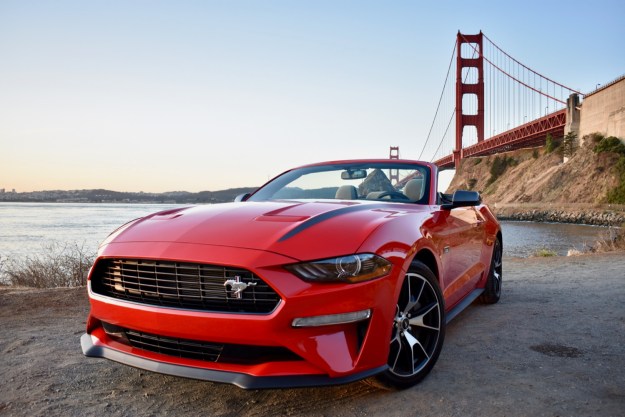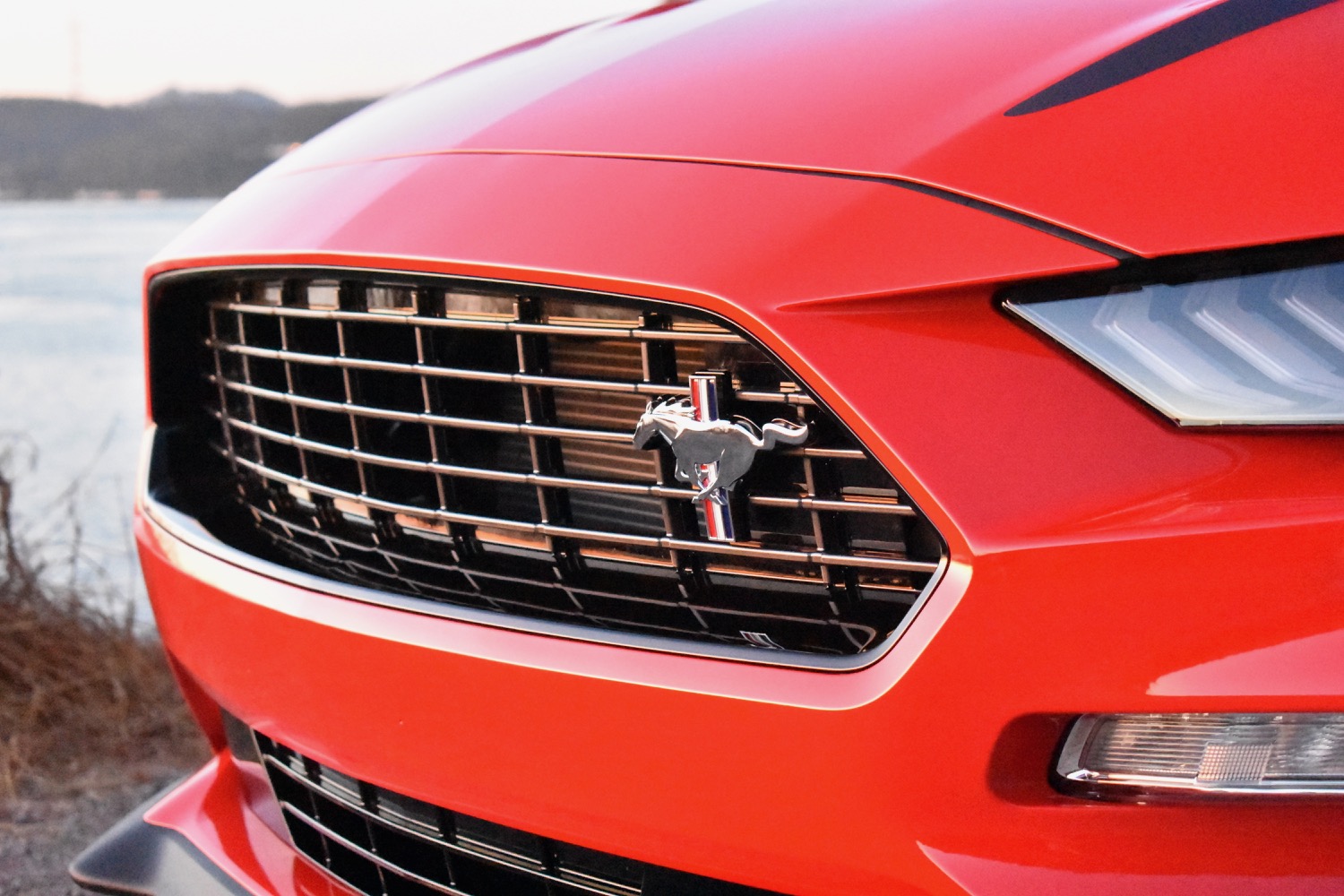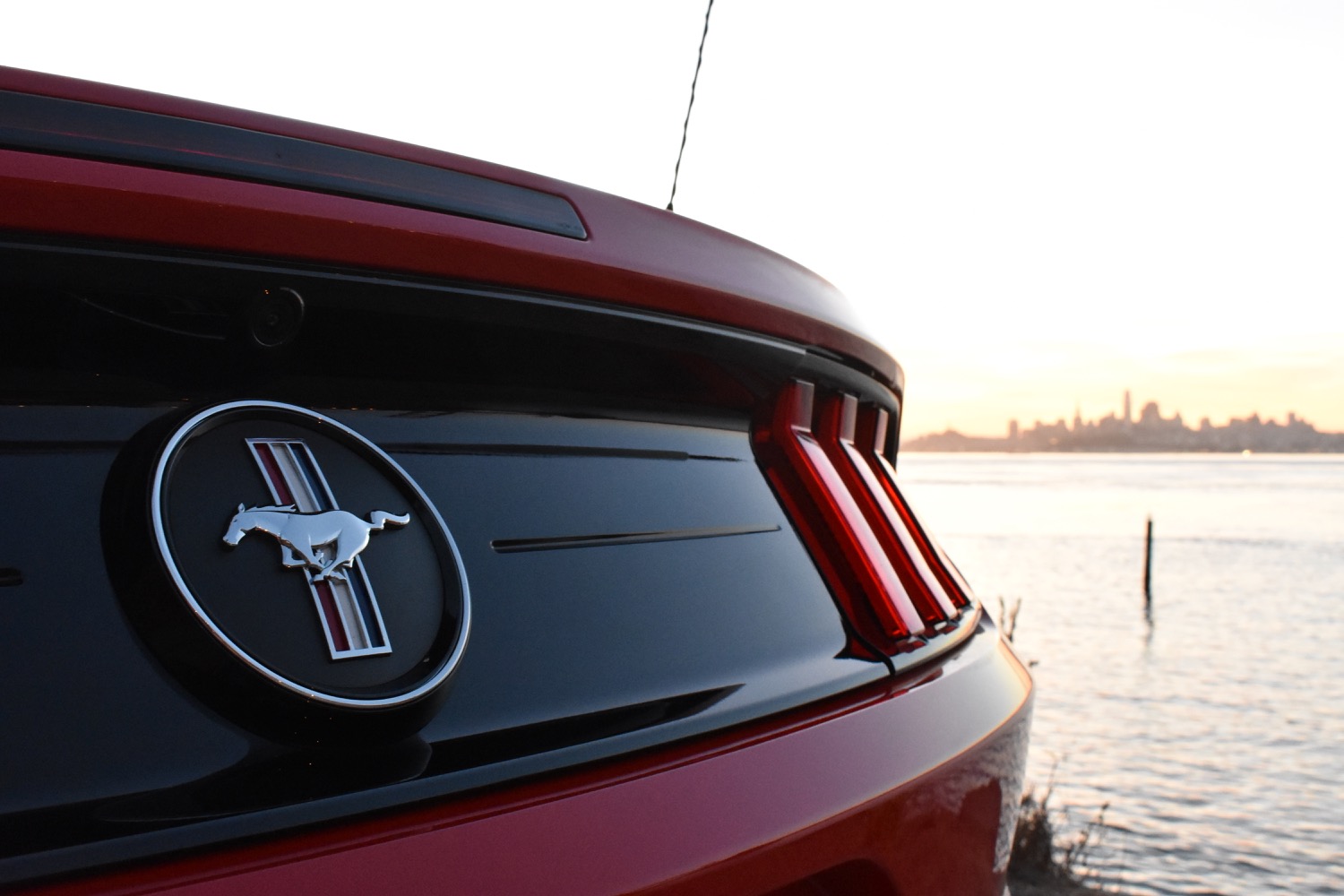
“With the High Performance Package, the 2020 Ford Mustang EcoBoost finally comes to life.”
- Plenty of power all the time
- Great exhaust sound
- Agile in the corners
- Good value
- Rough ride on base suspension
- Unimpressive fuel economy
Ford Mustangs and V8 engines go together like beer and cheeseburgers, but that doesn’t mean they’re inseparable. Ford has offered a 2.3-liter turbocharged EcoBoost four-cylinder engine in the Mustang since the current generation’s 2015-model-year launch, and for 2020 the Mustang EcoBoost gets a major upgrade in the form of the High Performance Package (or HPP, for short). It boosts output to 330 horsepower, and includes upgraded suspension and brakes for improved handling.
Why would Ford bother making a sportier four-cylinder Mustang when buyers can still get a V8? The idea isn’t unprecedented. From 1984 to 1986, Ford sold the Mustang SVO, a performance model powered by a 2.3-liter turbocharged four-cylinder engine – just like today’s Mustang EcoBoost. Fast forward to 2019, and Ford has stricter emissions standards to think about, not to mention gas prices that would knock the shoulder pads off a 1980s Mustang driver. Ford also has a ready-made rival in the form of Chevrolet’s four-cylinder Camaro 1LE.
So, can you really have the same amount of fun as a V8 with four fewer cylinders? To find out, we accepted an invitation from Ford to drive the 2020 Mustang EcoBoost HPP on roads around Sausalito, California. The performance package adds $4,995 to the base price of a 2020 Mustang EcoBoost (which starts at $27,765), and is available on both coupes and convertibles. We also tested cars with the optional Handling Package ($1,995), which ads MagneRide adaptive suspension and more aggressive tires.
Sleeper ‘Stang
In fan circles, a “sleeper” is a car that hides its performance capabilities behind nondescript bodywork. That’s exactly what this Mustang is. While a Mustang is always likely to attract a certain level of attention, this car’s lack of “5.0” and “GT” badges (indicating a V8 model) or the coiled snake of a Shelby GT350 or GT500, will lead the uninitiated to dismiss it as a refugee from a rental car lot. That’s part of the fun.

Those in the know will be able to spot a Mustang HPP through a few discrete details. The four-cylinder car gets a front splitter, belly pan, and brake-cooling ramps from the V8 Mustang GT Performance Package. These add-ons actually help reduce front-end lift and improve brake cooling, according to Ford. The 19-inch wheels, gray hood stripes, and badging are more about looks. The latter two items look like they came from Pep Boys. Along with the scowling front end all non-Shelby Mustangs adopted as part of a 2018-model-year refresh, they’re the only cosmetic blemishes on an otherwise fine-looking car.
Other than an aluminum dashboard panel, and oil and turbo-boost gauges most owners will probably never use, the interior is unchanged. The Mustang’s interior doesn’t have the clean, minimalist look of the Camaro’s, but it doesn’t have the Chevy’s bunker-like feel, either. Neither car can match the spacious feel of the Dodge Challenger’s cavernous interior, but the Dodge is just too big. It isn’t in the same league as the Mustang or Camaro when it comes to driving dynamics, so it isn’t really a fair comparison.
A “sleeper” is a car that hides its performance capabilities behind nondescript bodywork. That’s exactly what this Mustang is.
Like other Mustang models, the EcoBoost HPP gets an 8.0-inch touchscreen running Ford’s Sync 3 infotainment system, with Apple CarPlay and Android Auto. A 12.0-inch digital instrument cluster is also available, replacing the analog gauges with a reconfigurable display that can show up to eight virtual gauges They range from simple dials in Normal mode to a more elaborate setup in Sport+. The graphics were nice to look at an easy to read, but we’re also fans of the base analog gauge setup, complete with a speedometer labeled “ground speed.”
Hot hatch DNA
The 2.3-liter turbocharged four-cylinder EcoBoost engine used in the Mustang is related to the engine from the Ford Focus RS – the Blue Oval’s ultimate hot hatchback. That got some engineers at Ford’s Arizona proving ground thinking, “What if we put a Focus RS engine in a Mustang?”
So a team of five engineers took the engine out of a Focus RS test mule, turned it 90 degrees to fit the Mustang’s rear-wheel drive layout, and tested it out. The result was so good that Ford’s top brass approved the car for production, Carl Widmann, Mustang chief engineer, told Digital Trends.

The HPP people can actually buy wasn’t a straightforward engine swap, though. After proving the basic concept, engineers refined it to create a performance car with a different feel to the hyperactive (and no-longer-in-production) Focus RS. The Mustang uses the same engine block and cylinder head as the Focus RS, churned out be the same Valencia, Spain, factory. But the Mustang has a different turbocharger, a different exhaust system, and radiator, and different transmissions, including a Getrag six-speed manual and the 10-speed automatic shared with other Ford models, like the Ranger pickup truck.
The difference is apparent in the specs. The HPP’s 330-hp output (on premium fuel) is 20 more than a base EcoBoost Mustang, but 18 hp less than the Focus RS. With the Mustang, engineers were going for usability, not sheer horsepower, Widmann said. A bigger horsepower number might give owners more to brag about, but accessing that power would be harder. In contrast to the peak power delivery of the Focus RS, the Mustang makes all of its power through a broad swath of the rev range, all the way up to the engine’s 6,500-rpm redline, according to Widmann.
The changes add up to a lot more than just an EcoBoost Mustang with extra horsepower.
It’s the same thing with torque. Output is the same 350 pound-feet you get in a base EcoBoost Mustang, as well as the Focus RS. But 90 percent of that torque is available between 2,500 rpm and 5,300 rpm. Again, availability through a wider area of the tachometer’s sweep makes it easier to access the power on tap.
Ford claims the HPP allows the Mustang to do zero to 60 mph in the mid four seconds range. Top speed is estimated at 155 mph, compared to 131 mph for a car without the performance package. In addition to making the car faster in a straight line, Ford added a strut tower brace to stiffen the chassis, and stickier summer performance tires mounted on 19-inch wheels. The HPP also includes upgraded brakes from the Mustang GT, with larger four-piston calipers and front rotors.
A different breed
On the road, the changes Ford made add up to a lot more than just an EcoBoost Mustang with a little extra horsepower. The HPP transforms this car, giving it a character very different to the traditional V8 Mustang.
Instead of an all-American V8 roar, this Mustang emits the sound of a European hot hatchback. The HPP includes an active exhaust system that lets the driver choose different levels of loudness, from Quiet mode to Track mode. Switch it to Track mode, and you get a nice mechanical growl, accompanied by the whistle of the turbocharger. It’s a great soundtrack, and one we never expected to hear from a Mustang.

Like the exhaust note, the driving experience proves that you can teach an old Mustang new tricks. With its independent rear suspension, the current-generation Mustang was already pretty good in corners. But the HPP takes things to a whole new level. The tire, chassis, and brake upgrades – combined with the EcoBoost engine’s lighter weight – create quick, precise reactions that are more sports car than muscle car. Ford’s engineers weren’t kidding about usable power, either. This engine has remarkable flexibility, with ample power available throughout the rev range.
We tested cars equipped with both the 10-speed automatic transmission and the six-speed manual, and prefer the latter. The automatic is fine for highway cruising, but in the heat of battle it can be frustratingly indecisive. It constantly juggles its many gears for no obvious benefit. Granted, you can shift manually using steering wheel paddles, but if you’re going to do that, why not just get the manual?
The driving experience proves that you can teach an old Mustang new tricks
We also tested cars with the optional Handling Package, which adds more aggressive Pirelli P Zero Corsa 4 summer tires, a limited-slip differential for better traction, and Ford’s MagneRide dampers. They automatically adjust firmness based on a number of factors, ranging from speed to outside air temperature. The result is great handling without the penalty of a harsh ride. We were able to corner just as quickly with MagneRide as with the base suspension, but we were a lot more comfortable while doing it.
Downsizing from a V8 to an inline-four should come with a big boost in gas mileage. The 2020 Mustang EcoBoost HPP coupe is rated at 23 mpg combined (20 mpg city, 28 mpg highway) with the 10-speed automatic transmission, and loses one mpg in the highway category with the six-speed manual (convertibles lose an additional mpg in the highway category with both transmissions). That’s an improvement over a 2020 Mustang GT, which musters 19 mpg combined (16 mpg city, 25 mpg highway) with the automatic, but it’s not as dramatic as the difference in displacement might indicate. Expect fuel economy to take a hit when you drive aggressively, too.

The High Performance Package also comes with a fuel-economy penalty compared to the base Mustang EcoBoost, which is rated at 25 mpg combined with the automatic, and 24 mpg with the manual. The four-cylinder Camaro (ratings are the same with or without the 1LE package) gets better gas mileage with the automatic, at 25 mpg combined (22 mpg city, 31 mpg highway). But opting for a stick shift brings the race to a virtual dead heat, with the Chevy rated identically to the Ford in the combined and city categories, and an advantage of just two mpg highway.
The practical stuff
The Mustang is pretty light on driver aids. Autonomous emergency braking and adaptive cruise control are available, but only as optional extras. But it’s a similar story with other sporty cars in this price range.
Ford offers a three-year, 36,000-mile, bumper-to-bumper warranty and a five-year, 60,000-mile, powertrain warranty. Chevy offers identical coverage terms for its Camaro. The Mustang received a below-average reliability score from Consumer Reports, and does not have the best overall reputation for reliability. But that’s the case with the Camaro as well.
The 2020 Mustang received a five-star overall safety rating from the National Highway Traffic Safety Administration (NHTSA). At the time of publication, the Insurance Institute for Highway Safety (IIHS) had only tested a 2019 model, but ratings should apply to the 2020 model as well. The IIHS gave the Mustang coupe the top “good” score in all crash tests except the driver-side small frontal overlap, where the Mustang was rated “average.”
How DT would configure this car
Our ideal 2020 Ford Mustang EcoBoost High Performance Package would be a coupe with the six-speed manual transmission and the optional Handling Package. The smoother MagneRide suspension alone is worth the $1,995 price. The great thing about the High Performance Package is that it can be added to any existing Mustang EcoBoost options. So, you can build a basic car with just the performance upgrades to keep things as cheap as possible, or fully kit the car out with the things like the digital instrument cluster, upgraded audio, or heated and ventilated seats. The choice is yours.
Summary
The Mustang EcoBoost was once the car you bought if you couldn’t afford the V8-powered Mustang GT, but the High Performance Package has transformed the four-cylinder Mustang into something desirable. The combination of classic Mustang looks and the type of engine normally found in hot hatchbacks is a good one. The High Performance Package is also less hardcore than a Chevy Camaro 1LE, and more likely to work as a daily driver.
However, there are other options for buyers willing to broaden their horizons. Two-seat sports cars like the Mazda MX-5 Miata/Fiat 124 Spider and Subaru BRZ/Toyota 86 twins, as well as the Nissan 370Z can be had for similar money. So can a Volkswagen GTI or Subaru WRX, which are more practical than any of these cars. One thing is for sure: it’s a great time to be shopping for an affordable performance car.
Should you buy one?
Yes. An old American muscle car maxim claims “there’s no replacement for displacement.” In this case, there is.
Editors' Recommendations
- 2020 Chevrolet Camaro vs. 2020 Ford Mustang
- 2021 Ford Mustang Mach-E first drive review: Electric muscle
- The 2020 Ford Shelby Mustang GT350R remains hilariously hardcore





